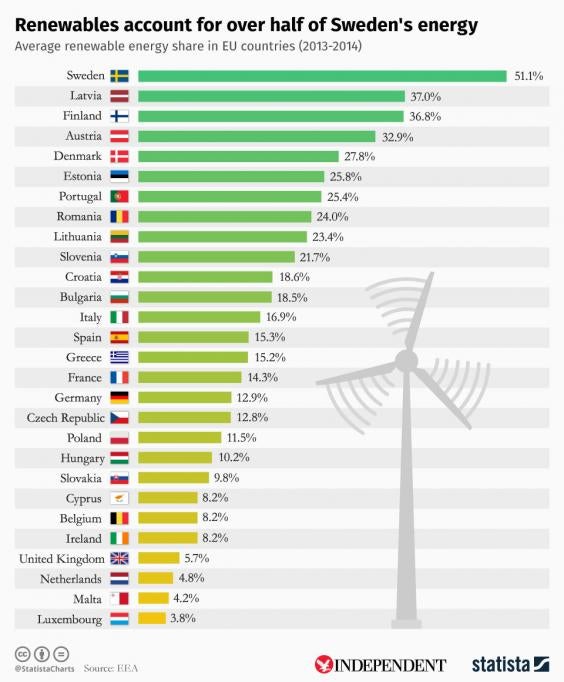




The country aims to be 100-percent fossil-fuel-free by 2050,

Case study: Sweden
Last year, 57 per cent of Sweden's power came from renewables such as hydropower and wind sources, with the remainder coming from nuclear power.
The country now plans to tap into its "large potential" for onshore wind power, in order to make the country completely fossil-free by 2040 - a goal set by Sweden's prime minister at the UN General Assembley last year.
"We are not densely populated, we have a lot of good places to put land-based large-scale wind and there is large potential for that in Sweden," Anne Vadasz Nilsson, Director General of the Swedish Energy Markets Inspectorate
almost 100% of Iceland's electricity comes from renewable sources, due to its investment in hydropower and geothermal energy production
Power for a sustainable future
Sweden has invested heavily in the search for alternative energy sources ever since the oil crisis of the early 1970s. In 1970, oil accounted for more than 75% of Swedish energy supplies; today, the figure is around 20%, chiefly due to the declining use of oil for residential heating.
Low emissions
Few countries consume more energy per capita than Sweden, yet Swedish carbon emissions are low compared with those of other countries. According to the latest statistics from the International Energy Agency (IEA), the average Swede releases 4.25 tonnes of carbon dioxide (CO₂) per year into the atmosphere, compared with the EU average of 6.91 tonnes and the US average of 16.15 tonnes. Sweden has found a way to reduce emissions while the economy is growing.
The reason for this low emission rate is that 83% of electricity production in Sweden comes from nuclear and hydroelectric power. Cogeneration from combined heat and power (CHP) plants accounts for 10% of the electricity output in Sweden, and these are mainly powered by biofuels. About 7% of the electricity comes from wind power.
IKEA:
Other sectors are also putting greater emphasis on green energy and energy conservation. IKEA, the Swedish multinational furniture retailer, adopted a new sustainability strategy in 2012. Its aim is not just to conserve more energy and invest in renewable power such as wind farms, but also to help customers make sustainable choices, such as in their choice of light bulbs or by taking a free IKEA bus to and from the store rather than using a car. In 2014, IKEA’s renewable energy production represented 42 per cent of its total energy use. That year, IKEA also had a 58 per cent increase in sustainable product sales compared with 2013. IKEA aims for renewable self-sufficiency by 2020, wherever it operates around the world.
Evaluation:
- We can't say renewable energy is geographical due to advances in technology
- Small-scale / grassroots / bottom-up schemes and localised solutions are a great way for a knock-on-effect
- Transportation / consumption / big TNCs are key areas to target
- Solutions that have economic considerations
No comments:
Post a Comment